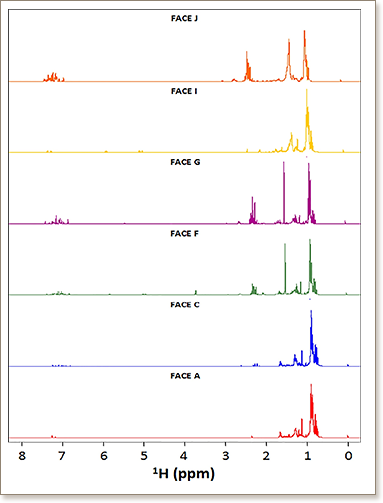A minimalist functional group (MFG) approach for surrogate fuel formulation


Surrogate fuel formulation has drawn significant interest due to its relevance towards understanding combustion properties of complex fuel mixtures. In this work, we present a novel approach for surrogate fuel formulation by matching target fuel functional groups, while minimizing the number of surrogate species. Five key functional groups; paraffinic CH, paraffinic CH, paraffinic CH, naphthenic CH–CH and aromatic C–CH groups in addition to structural information provided by the Branching Index (BI) were chosen as matching targets. Surrogates were developed for six FACE (Fuels for Advanced Combustion Engines) gasoline target fuels, namely FACE A, C, F, G, I and J. The five functional groups present in the fuels were qualitatively and quantitatively identified using high resolution H Nuclear Magnetic Resonance (NMR) spectroscopy. A further constraint was imposed in limiting the number of surrogate components to a maximum of two. This simplifies the process of surrogate formulation, facilitates surrogate testing, and significantly reduces the size and time involved in developing chemical kinetic models by reducing the number of thermochemical and kinetic parameters requiring estimation. Fewer species also reduces the computational expenses involved in simulating combustion in practical devices. The proposed surrogate formulation methodology is denoted as the Minimalist Functional Group (MFG) approach. The MFG surrogates were experimentally tested against their target fuels using Ignition Delay Times (IDT) measured in an Ignition Quality Tester (IQT), as specified by the standard ASTM D6890 methodology, and in a Rapid Compression Machine (RCM). Threshold Sooting Index (TSI) and Smoke Point (SP) measurements were also performed to determine the sooting propensities of the surrogates and target fuels. The results showed that MFG surrogates were able to reproduce the aforementioned combustion properties of the target FACE gasolines across a wide range of conditions. The present MFG approach supports existing literature demonstrating that key functional groups are responsible for the occurrence of complex combustion properties. The functional group approach offers a method of understanding the combustion properties of complex mixtures in a manner which is independent, yet complementary, to detailed chemical kinetic models. The MFG approach may be readily extended to formulate surrogates for other complex fuels.
DOI: 10.1016/j.combustflame.2018.01.036

"KAUST shall be a beacon for peace, hope and reconciliation, and shall serve the people of the Kingdom and the world."
King Abdullah bin Abdulaziz Al Saud, 1924 – 2015
Thuwal 23955-6900, Kingdom of Saudi Arabia
© King Abdullah University of Science and Technology. All rights reserved